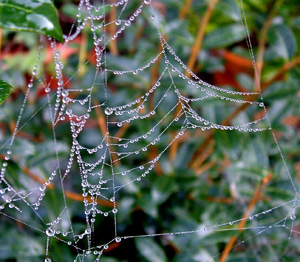Wildlife Gardening for Children
Things that children can do to encourage and help wildlife in the garden

Wildlife gardening isn't just about helping other creatures to survive. If you have a thriving population of birds, beetles, insects, worms, frogs and small mammals in the garden, they will naturally carry out many of the jobs that you wouldnít particularly want to do yourself.
Wildlife gardening - food-chain
Birds, frogs, toads and hedgehogs will eat slugs and snails and birds, ladybirds, wasps and hoverfly larvae will eat green and blackfly. This means that you donít need to automatically reach for the slug pellets or the spray gun, just wait for nature to do the job for you. Remember that even the creatures you donít like are part of the food chain and provide a meal for something else.
So, a greenfly will feed on a leaf, be eaten by a ladybird, which may then be eaten by a bird. A well balanced garden is a mass of food chains and the more wildlife friendly it is, the more creatures it will feed. It will also be a lot more interesting for you and a lot more attractive and comfortable for the creatures who live there.
Wildlife garden in Winter
In winter, itís easy to stay indoors and turn our backs on the garden. Itís cold and if it isnít icy, itís damp and foggy, and not half as much fun to be outside as it was in summer, when the air was nearly always warm and the garden full of scent and colour.
We humans are lucky. We can shut the door on all that and turn the heating on, but the wild creatures that live in our gardens donít get that choice and, with most of the winter still ahead of them, may find it hard to survive the cold months till spring. There are many ways you can help the wildlife in your garden, and many are surprisingly easy and quick to do.

A ladybird sheltering in a seed pod
Click on the pictures below to see ideas for helping garden wildlife
Birds
Ladybirds
Frogs and other pond creatures
Bees
Hoverflies
Butterflies
Mammals
Spiders
Something to think about at bedtime
When you get ready for bed at night, think about all the other creatures that share your world who are also getting ready for bed. As it gets dark, the wildlife you have attracted to your garden like birds, bees, hoverflies, butterflies, ladybirds and other insects will all be falling asleep. Some will be tucked into bushes, or nests if it is breeding season, while others are under leaves or flowers, in wood piles or in tiny gaps in walls.
As their day ends, so it begins for a host of other creatures whose daytime is our nighttime. Hedgehogs will be waking up and thinking about breakfast - if you look into the garden just after it gets dark you might be lucky enough see one trundling about through the flower beds or trotting across the lawn, though it might be more likely that you'll hear one as hedgehogs can be quite noisy little animals, rustling and snuffling as they go about their business.
Along with the hedgehogs, frogs, toads and newts will be waking in their shelters under rocks or logs and will start to explore the garden looking for insects, slugs and worms to eat. Foxes, badgers, bats, shrews, voles and mice are also active at night. In fact, there is a whole world of animals living very close to most of us that we hardly ever see. By helping them, you are helping all life around you to thrive.

© Copyright Miranda Hodgson 2007







